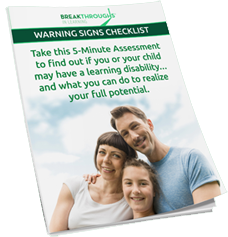
Does it affect life at home, at school or at work?
Take 5 minutes to complete the Warning Signs Checklist and discover whether you or your child could have learning difficulties that are impacting your life, and what to do about it.
Take The Free Warning Signs Checklist!
This month we are talking about reading, specifically looking at eye tracking and associated dysfunctions. Last week we talked about two types of eye tracking: fusion and pursuit. This week’s topic is often confused with poor eye tracking, but is in fact, very different. Let’s take this opportunity to clarify those differences.
Have you ever watched someone mix up their letters or numbers as they read? They may think that a ‘b’ is a ‘d’, a ‘p’ is a ‘q’, or that a ‘6’ is a ‘9’. This may be a visual discrimination problem, even though it has very similar characteristics to the eye tracking dysfunctions discussed last week. We need visual discrimination to quickly see the small visual details in things. Without this brain skill, we may have a problem seeing the similarities and differences in shapes, (a circle is similar to an oval, a triangle is more similar to a square than a circle) colours, sizes, patterns, positions and orientations. This will affect the way we understand and use similarities and differences in words, letters, shapes, pictures and other objects. You can imagine how weak visual discrimination would make it very difficult to learn to read.
According to Dr. Jacques Duff, a visual processing disorder refers to a reduced ability to make sense of information taken in through the eyes. This is different from problems involving sharpness of vision. Difficulties with visual processing affect how visual information is interpreted and processed by the brain. A person with visual processing problems may have 20/20 vision but still have difficulties discriminating foreground from background, forms, size, and position in space.
Another noticable effect of poor visual discrimination is that the child often appears immature for their age. This child may feel more comfortable with younger peers and tends to make friends who are younger than they are.
There are other implications, too. Children with underdeveloped visual discrimination (unable to easily see small visual detail) often have underdeveloped judgment skills as well. This affects their ability to make good decisions. Interestingly enough, when the State of Arizona projects how many prison beds it will need, it factors in the number of children who don’t read well by fourth grade. (Arizona Republic 9-15-2004)
Breakthroughs in Learning has created a series of workbooks to develop the foundational skills under learning. The Brain Booster series has two levels for Eye Tracking and four levels for Visual Discrimination. Visual discrimination not only affects a child’s ability to read but also their view of reading and learning in general. The frustration of not understanding a sentence because one letter is misinterpreted is a very significant concern for a child, and may affect the way they view the reading experience. “This sentence doesn’t even make sense so what’s the point of reading?!”
At Breakthroughs in Learning, we assess and develop visual discrimination in many of our clients. This is clearly a separate brain skill from eye tracking, though both relate to the eyes, and both affect reading. In order to help the client, it is vital to assess which of these skills needs the work. Note that it is possible for both areas to need work. Reading is a skill that can open the world of learning or effectively shut someone out. Assessing correctly and addressing correctly can make a life changing difference for an individual. We have seen many persons of all ages increase their ability to read, do math and make use of their improved judgment skills. In our next blog we will discuss some tools that encourage growth in the brain skills that underlie successful reading.
Subscribe to our newsletter and receive regular articles and resources to help you or your child perform better at school, home or work.
suscribe now
Post Your Comment Below